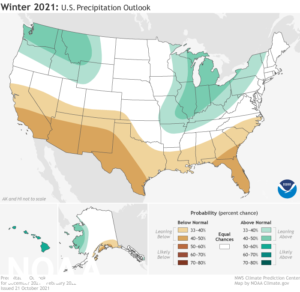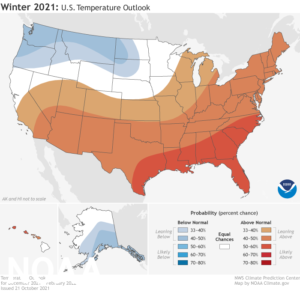2021-2022 Winter Outlook
October 21, 2021, – Forecasters at NOAA’s Climate Prediction Center released the 2021-2022 U.S. Winter Outlook.
“Above-average temperatures are favored across the South and most of the eastern U.S. as La Nina climate conditions have emerged for the second winter in a row according to NOAA’s Climate Prediction Center — a division of the National Weather Service. In NOAA’s 2021 Winter Outlook — which extends from December 2021 through February 2022 — wetter-than-average conditions are anticipated across portions of the Northern U.S., primarily in the Pacific Northwest, northern Rockies, Great Lakes, Ohio Valley and western Alaska.”
” If this post gives you a feeling of déjà vu, I can understand why; for the second year in a row, La Niña has developed and is expected to impact the U.S. weather and climate during the upcoming winter. Will we see a typical response to La Niña this year (sure didn’t see it last year) or will other factors play a more significant role than La Niña again this year? Are La Niña impacts more reliable in the second year of a “double-dip” event? Finally, how will the update to the long-term temperature and precipitation averages affect the outlooks? So many questions, so little time, so let’s get started!” said Mike Halpert, deputy director of NOAA’s Climate Prediction Center.
The 2021 U.S. Winter Outlook (December through February):
Precipitation
- The Pacific Northwest, northern Rockies, Great Lakes and parts of the Ohio Valley and western Alaska have the greatest chances for wetter-than-average conditions.
-
Drier-than-average conditions are favored in south-central Alaska, southern California, the Southwest, and the Southeast.
- The forecast for the remainder of the U.S. shows equal chances for below-, near- or above-average precipitation during winter months.
- Warmer-than-average conditions are most likely across the Southern tier of the U.S. and much of the Eastern U.S. with the greatest likelihood of above-average temperatures in the Southeast.
-
Below-average temperatures are favored for southeast Alaska and the Pacific Northwest eastward to the northern Plains.
- The Upper Mississippi Valley and small areas of the Great Lakes have equal chances for below-, near- or above-average temperatures.



